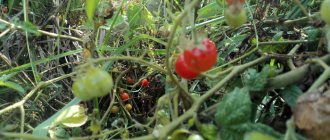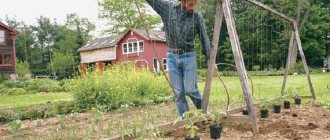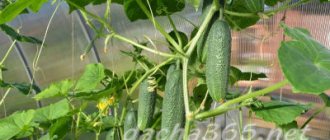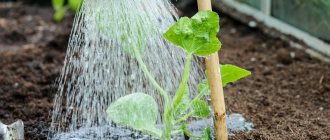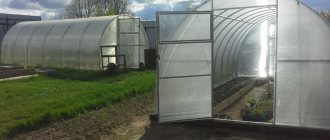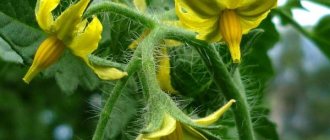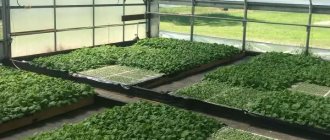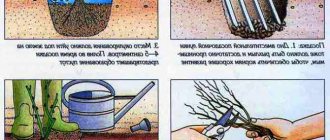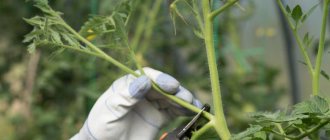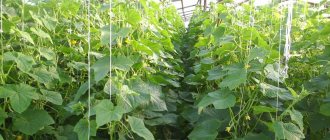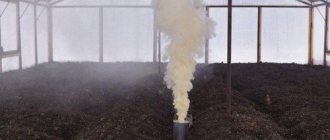Regularity of pruning
Pruning and sanitary pruning of plants in a greenhouse is carried out at least twice a month. When to pick off the lower leaves, the ripeness of the fruit on the first cluster from the ground will tell you. When the tomatoes turn white, you can safely remove the bottom 2-3 leaves. As the fruits ripen, the bush is exposed higher and higher.
- How to care for tomatoes - planting, watering, fertilizing and the main nuances of growing. Tips and secrets of caring for tomatoes for beginners (110 photos and videos)
- Feeding tomatoes and cucumbers with yeast: recipes and video instructions on how to properly feed vegetables using yeast (105 photos)
- Boric acid for tomatoes: methods of use as a fertilizer for the garden. Expert advice and detailed technology for applying boric acid to tomatoes (90 photos + video)
What leaves are removed from tomatoes during sanitary pruning:
- yellowed;
- dried out;
- with suspicious spots and clutches of insect eggs;
- touching the ground;
- thickening the bush and lying on the fruits (these leaves are removed partially, half).
When pruning, more than 10% of the green mass is removed. Healthy shoots and leaves are used to protect berry crops from harmful insects. If plants grow in open ground, pruning can be done less frequently. Without insulation, even tall varieties do not grow above 2 meters.
How to pinch the tops of tomatoes
Not everyone knows that you need to pinch tomatoes in a greenhouse. The fact is that the tomato directs all its forces to growth in height. If summer lasts all year round, then the ovaries have time to fill. Even in a polycarbonate greenhouse, the crop can be kept from April to October. This time is often enough to form 4-5 bunches of tomatoes. The remaining tomatoes will remain small and green and are unsuitable for consumption.
When a certain number of branches with vegetables are formed on each stem, the growth of the tomato under the film is limited by trimming the crown. Tall and short-growing plants undergo the procedure. There is no need to prepare them for trimming before pinching them. They tolerate top removal well.
On a bush formed from several stems, each crown must be removed. After pinching, all the vital forces of the bush will be directed to the growth of fruits. They will increase in size significantly; you can harvest giant tomatoes if frost is not expected in the near future. The costs of purchasing and maintaining a greenhouse must be recouped. If you are not getting a harvest indoors, then you should become better acquainted with how to pinch tomatoes, trim leaves and shoots.
Description
Tomato is a type of vegetable plant of the nightshade family with juicy fruits of various shapes (multi-locular berries). In order to get as many fruits as possible, tomatoes need to be systematically pruned and shaped at different stages of growth: starting from seedlings, then during growth in the greenhouse and ending with care in the garden. It is necessary to trim the leaves of the plant so that the tomato receives enough sunlight and does not grow in the shade from leaves from other stems. In poor lighting, tomatoes may begin to grow too slowly or even wilt. In addition, excessive leaf cover takes energy from the stem, which it should direct to the formation and ripening of tomatoes.
Stages of crown formation
The crown of a tomato bush is formed in several stages:
- Stepsonning.
- Pinching the top.
- Removing leaves.
A properly formed bush will always give a greater harvest
It is important to carry out all these stages on time, preventing the bush from growing. The greenhouse grower's task is to remove all unnecessary greenery and direct the beneficial substances coming from the tomato stems, leaves and roots directly to the fruit cluster
Stepsoning
Tomatoes can be grown with one or two or three stems. If you decide to leave only the central stem, all lateral ones must be destroyed. If there are several, then it is worth leaving for fruiting those stepsons that are closest to the main cluster with fruits. A bush with a total of no more than three stems and eight brushes is considered ideal.
The stepsons are removed with a sharp knife or simply with your hands. The main thing is not to damage the main stem.
Stepchildren are carried out as the stepsons grow; it is desirable that they are less than 5-8 cm in height, but have already formed a stem. It is necessary to regularly inspect the tomato bushes in the greenhouse (every 10-12 days), cutting off the side stems. It is better to remove stepsons in the morning with a sharp knife or even a fingernail, without damaging the main stem.
You cannot break off the entire stepson, otherwise a new one will grow in its place after a while. To prevent this from happening, you need to leave a piece of the stem - a stump 2-3 mm long.
Pinching the top, or topping
Topping is done for the same reason as pinching. When the bush is already formed and a sufficient number of clusters form fruits, you need to stop the growth of the main stem. Throughout the growing season, it stretches upward, producing more and more new shoots and ovaries.
Topping a tomato bush
As a rule, the procedure for pinching the top falls in the middle or end of July. The top of the stem is cut with a sharp knife at the level of the third or fourth leaf above the ovary; two or three leaves should remain for the full development of the fruit.
Important! Trimming the top will stop unnecessary growth of the bush so that the plant can devote all its strength to ripening the already formed tomatoes.
Removing leaves
When the fruits on the tomatoes in the greenhouse have already set and grown, the process of their ripening begins. From green they first become whitish, then brown, and only then acquire their final color
It is believed that during the period of fruit ripening, leaves no longer play an important role. On the contrary, they weaken the plant, taking away some of the beneficial substances destined for the brushes.
It is especially important to remove the lower leaves, as by this time they turn yellow and curl. Greenhouse growers have differing opinions on this matter.
Some vegetable growers believe that it is necessary to remove all leaves except the very top ones, others argue that leaves are actively involved in the process of photosynthesis, so only diseased leaves and those that shade the fruits are removed.
Scheme: formation of a tomato bush
Leaves must be removed with extreme caution, otherwise gray rot may appear at the cut site. To prevent this from happening, it is better to do the work in the first half of the day in sunny weather.
In this case, by evening the sections will have time to dry. You can go the other way, lubricating each cut with a disinfectant solution to prevent the development of the disease.
For this, 2 tbsp. fluff lime is mixed with 1 tbsp. copper sulfate, and then diluted with water to a liquid slurry. This procedure is required if pruning leaves is done in damp or cloudy weather.
Pruning tomatoes in a greenhouse video
To gain more insight into proper pruning, especially for beginners, it is helpful to watch the video.
Dates
Start pinching tomatoes as soon as the flowers in the lower cluster open. Usually the first procedure is carried out 2 weeks after planting the seedlings.
But you need to understand that the timing of stepsoning can be blurred for everyone. Some people carry out the first procedure simultaneously with gartering the tomato.
It is important not to let the bushes on the windowsill outgrow, since it is undesirable to shift the processing time - first the seedlings must adapt after transplanting into the ground.
In the future, it is necessary to carry out pinching every 10-14 days.
For surgery, choose a warm, clear day. The optimal time for this work is from 9 to 11 o'clock.
It is easier to break off sprouts in the morning, pinching is less damaging to the plants, and it is important that the wounds have time to heal by evening.
Why trim?
Tomatoes growing in greenhouses are pruned due to the limited enclosed space. Under such conditions, the risk of the development and spread of diseases affecting tomatoes increases and the care of tomato plantings becomes more difficult. Due to insufficient lighting, full photosynthesis is disrupted, affecting the quality of ripening fruits, and in the shade, the tomato ovaries that appear begin to rot. Proper pruning of tomatoes in a greenhouse will allow you to:
- accelerate the ripening of vegetables,
- minimize damage to plantings by infectious bacterial and fungal diseases,
- increase vegetable yields,
- provide proper care for tomato bushes.
Pinching involves cutting off excess shoots that form at the junction of the leaf cuttings with the central stem. Usually this procedure begins a couple of weeks after planting the tomato seedlings in the greenhouse, when the plants take root completely and begin to grow.
It is much easier to prune tomato bushes at the initial stage of growth: the plants are still low and it is clearly visible which stepsons should be trimmed and which ones should be left.
Follow the recommendations
It is recommended to plant tomato plants depending on their variety:
- Indeterminate varieties and hybrids form 1 stem. Their first tassel appears above the 10th or 11th leaf, the subsequent ones are left every three.
- In tall varieties, a bush of 1-3 stems is formed. Otherwise, with a large number of central stems, the bush begins to be overgrown with leaf mass, therefore it is recommended to give preference to forming it into 1 trunk, cutting off the lateral shoots. If you intend to leave the 2nd or 3rd additional stepsons, they are formed under the first brush.
- Superdeterminate and determinate early varieties do not require pinching, but can be pinched to give the plant the desired shape.
There are no strict pruning rules that must be followed. It is believed that any plant can easily tolerate the removal of up to three leaves twice a week. Sometimes a bush needs a more global procedure if a dangerous disease develops on it.
Gardeners remove foliage in various ways. But it is best to choose the one that is more convenient and less harmful to tomato crops.
Do not abruptly tear off the foliage, pointing it downward. This way you will leave large wounds on the plant, in which bacteria will immediately begin to grow.
You can break off the leaves by turning them slightly to the side in a clockwise direction, but this scheme is not ideal.
You can break off the leaves by turning them clockwise
To do everything correctly and not injure the plant, we advise you to do the following:
- perform the procedure in warm weather;
- Prepare sharp scissors and a small container of hydrogen peroxide in advance;
- the tool trims excess foliage - this will be more convenient and faster;
- the wound is treated with peroxide to protect the plant from disease.
Removing stepchildren
During the growth process, the very first leaves located below begin to age, come into contact with the surface of the soil, turn yellow and become covered with spots. They are the ones who provoke air stagnation in the greenhouse and the development of diseases. If you think about it, they have fulfilled their function, the plant no longer needs them.
During the growth process, the first leaves that appear begin to age and need to be removed.
Fading foliage often becomes a source of diseases, which in greenhouse conditions quickly affect those around the bush.
The general recommendation for pruning a plant is to form a bush in a greenhouse with one to three stems and the presence of no more than eight flower clusters.
Tomato stem and leaves
A video instruction or the following recommendations will help you master the technique of pinching plants:
- The first planting of tomatoes is carried out 12-15 days after the day of planting the seedlings.
- The main stem is determined by the formation of the first flower cluster.
- Shoots growing in the axils of the leaves of the main stem are removed when they become 5-7 cm long.
- To prevent a new stepchild from forming in the same place, leave a “stump” 2-3 cm long.
- If you plan to grow tomatoes in 1 stem, remove all new stepsons. When a bush of two or three stems is formed, a stem is left that grows under the very first inflorescence.
- Stepchildren of secondary stems also need to be removed.
- No more than four flower clusters are left on each stem. The excess ones are cut off so that the plant can save energy for the development and ripening of already established future tomatoes.
Many gardeners are wondering how to prune tomatoes in a greenhouse correctly so as not to harm the developing plant.
This becomes especially relevant in those regions where tomatoes ripen for quite a long time, and cultivation in special greenhouses is aimed at accelerating their growth and development.
Due to some of its natural characteristics, a tomato bush is not able to produce a full harvest without timely human intervention.
Any tomatoes have one unpleasant sign: in the depths of almost all leaves a new stepson can grow. An overgrown stem can produce a secondary stepson. These stems are independent, they are able to bear fruit in the future.
It would seem that what is so harmful about this? But the fact is that quite a lot of similar branches can grow on one bush.
This plant can spend a lot of effort on setting fruit on small stepsons, but it still won’t be able to give them proper nutrition.
Some gardeners begin to leave stepsons with a formed ovary, which will definitely not have time to ripen in time; it can cause more harm than tangible benefit.
Another compelling argument for pruning tomato bushes in greenhouse conditions is that an unpruned bush is much more susceptible to various infections. The risk of late blight infection here is quite high, because this contagious disease actively develops against the background of high humidity.
This is especially important for fruiting clusters. Properly trimming tomatoes in a greenhouse is not just some single simple action, but a whole set of measures, which includes the following steps:
Properly trimming tomatoes in a greenhouse is not just some single simple action, but a whole set of measures, which includes the following steps:
- primary stepsoning;
- necessary pinching of overgrown tops on tomatoes;
- cutting off excess leaves.
Successful cultivation of tomatoes in a greenhouse is possible with the presence of 1-2 stems on a fruiting bush. You can leave only the central powerful stem for fruiting, and all lateral excess should be cut off. A pruned tomato bush with 3 strong stems and 8 fruiting brushes remaining is considered ideal for comfortable fruit ripening.
Many beginning greenhouse growers do not know how much to cut off from a shoot, they pinch off everything, and then after a short time they find new shoots in the same place. Therefore, you should not tear off the entire tomato shoot; you can leave a small stump to avoid its re-growth.
Negative consequences of thickening a tomato bush in a greenhouse
Tomatoes have this peculiarity: from the axils of all leaves of a tomato bush, without exception, a stepson grows. Each such stem also grows a secondary stepson, etc. In principle, stepsons are completely full-fledged stems on which a cluster can form and bear fruit.
But this is precisely the main problem. A lot of such branches can grow on each bush. Can you imagine if each stepson begins to set fruit, trying to fulfill its function? The plant will spend all its energy on the development of stepsons and their ovaries, but, unfortunately, will not be able to provide adequate nutrition.
Important! There is no need to feel sorry for the ovaries that have just begun to form on the stepsons, since they still will not have time to ripen and will do more harm than good. Another argument in favor of pruning tomatoes in a greenhouse: a thickened bush is more prone to disease infection
Another argument in favor of pruning tomatoes in a greenhouse: a thickened bush is more prone to infection with diseases.
For example, late blight, the most common and destructive disease for tomatoes, develops in conditions of high humidity. That is why it is recommended to regularly ventilate the greenhouse in which tomatoes grow, and to water the plant exclusively at the root. Many leaves and stepsons do not allow air to circulate freely between the stems.
Access to sunlight to fruits during their ripening period is especially important; well-lit clusters will ripen much faster than those hidden in dense foliage.
The nutritional value
Tomato is a very important and valuable vegetable. Tomatoes are consumed fresh, for the production of concentrates, juices, sauces, ketchups, baby food, canned meat and fish, and soups. Tomatoes can also be pickled, canned, dried and dried.
Tomato fruits contain 5-8% dry matter, depending on the variety.
They also contain:
- vitamin C;
- provitamin A;
- B vitamins;
- red varieties contain more lycopene;
- yellow-colored varieties contain β-carotene.
Tomato is a low-calorie vegetable that can be successfully found in every person’s diet. It is not recommended to eat unripe green tomatoes, as they may contain substances that are toxic to the human body.
Mistakes gardeners make when planting
Incorrectly carried out pinching can create additional problems for the gardener. Let's look at the main mistakes that are made during this procedure:
- Erroneously deleting the wrong shoot.
In young plants, it is not always possible to determine which of the shoots is the main one, and the gardener may mistakenly cut off the wrong stem. If you doubt whether he is really a stepson, it is better to wait until he is a little older to be sure.
- The blades of scissors should be as sharp as possible.
A blunt instrument can seriously injure the plant, since it is not always possible to cut a branch the first time.
- It is advisable to wipe the scissors with a disinfectant solution, at least the same potassium permanganate, during the pinching process after processing each bush. Those who neglect this rule can easily transfer the infection from a diseased bush to other plants, spreading it throughout the greenhouse.
- Some people cut off the shoot at the root; as a result, after a while a new shoot grows in the same place. The stump left should not be shorter than 1.5 cm.
- Leaving cut shoots inside the greenhouse can cause an outbreak of infection. After the procedure, all branches must be removed.
- Beginners can start planting standard tomatoes, but this is wrong. In such varieties, stepsons are able to form, but their further growth does not occur and this does not affect fruiting in any way. It is not customary to plant standard tomatoes.
Anyone who grows tomatoes in a greenhouse needs to know not only what varieties are shaped and how, but also do it in compliance with all the details. Over time, any summer resident will gain the necessary experience and will be able to get by without the help of tips. A beginner simply needs to study all the recommendations so as not to be disappointed in the fruits of his labor and get the long-awaited magnificent harvest of his own tomatoes.
Tomato varieties
- Ideterminate - tall plants 1.5-2 m high;
- Determinate – medium-sized;
- Superdeterminants are short-growing.
For each type of tomato, a specific pruning method is selected.
Leaf trimming
Today, more and more people prefer to grow tomatoes in a greenhouse. How to properly prune tomatoes in a greenhouse? After all, this is also an important procedure that should not be ignored.
Pruning of leaves is carried out not only to eliminate thickening of the bush. The leaves should be removed at the moment when all the tomatoes have grown on the first bunch and they begin to ripen. Remove those leaves that are lower, because they only take away the strength of the plant.
How to properly trim tomato leaves in a greenhouse? Let's figure it out. Most often, by the time the first fruits begin to ripen, the lower leaves turn yellow. When they come into contact with the ground, they can cause the development of many diseases, including late blight. Remember that tomatoes are prone to developing this disease. Therefore, cut foliage must be immediately removed from the greenhouse.
So, when to trim the leaves of tomatoes in a greenhouse? Like tassels, they should be removed before lunch in clear weather.
It is important that the cut dries well. It is necessary to monitor the growth of tomato
The leaves are removed higher up the stem, under each infused brush. You can remove 2-3 leaves at a time, no more.
Those leaves that are located in the middle of the bush are also removed. They are weakly involved in photosynthesis. Be sure to trim off diseased leaves.
Predecessors
If you grow tomatoes on the bottom for 3 years, then the yield will subsequently drop by fifty percent, due to the fact that the same elements of mineral nutrition are removed from the soil and due to the massive damage to plants by pests and diseases that are increasingly developing in the soil . Excellent precursors for tomatoes are:
- legumes (except beans);
- carrot;
- onion;
- cabbage;
- cucumber.
It is forbidden to plant tomatoes after nightshade crops (potatoes, eggplants, peppers).
You can plant after these vegetables.
You can return to the same place after four years.
Types of pinching
There are several types of pinching, which differ in the amount left during the removal of excess shoots and branches. Each of these types has its own characteristics, which will be discussed in more detail below.
In one stem
The method of forming into one stem is excellent for bushes grown in a greenhouse. In this case, there will be no extra branches thickening the plants, which will provide them with good ventilation and sufficient light.
Immediately after the stepson begins to grow under the first formed brush, it should be cut off. At the same time, the lower leaf plates are also torn off from the bushes, which only hinder them at this stage of development. Next, carry out a systematic inspection of the bushes and cut off all emerging side shoots, while flowering brushes must be left behind.
Thanks to this method of forming a bush, about 50 brushes can grow on it, on which fruits will form. This method also allows you to extend the fruiting period.
In two stems
Forming a bush into two stems is also well suited for greenhouse tomatoes. In this case, you need to leave only one most powerful stepson, which grew under the first flowering brush. Those side shoots, as well as leaf plates that are located below this stepson, must be torn off. In the future, systematically inspect the bushes and cut off all excess shoots.
Three stems
Bushes formed into three stems are most suitable for growing in open ground, but not for a greenhouse. To form a plant into three stems, you need to cut off all the side shoots except two. The first stepson should be under the first flowering brush, and the second one should be above it. Next, the tomatoes are regularly inspected and excess shoots are removed.
Mistakes gardeners make when planting
Sometimes, when removing shoots from tomato bushes growing in a greenhouse, gardeners make serious mistakes that can cause the plants to become infected with infectious diseases or yield loss. Common mistakes:
- Untimely stepsoning. Excess side shoots must be removed systematically and in a timely manner. If you carry out such a procedure once a month or even less often, then it will be of little use. The fact is that long and thick stepsons will already have time to take away a significant part of the bush’s strength.
- Pruning not the stepsons, but the fruit branches. Often, inexperienced gardeners confuse these shoots. Carefully inspect the location where the shoot grows. If it does not grow from the leaf axil, but directly from the stem, then it is a fruiting branch and does not need to be cut off.
- Dirty tools. Experienced gardeners recommend removing stepchildren by hand. But if you use scissors for this, then be sure to disinfect them after trimming each bush. To do this, it is recommended to wipe them with any disinfectant solution, for example, a solution of potassium manganese. If this is not done, then from one diseased bush the infection can be spread to all bushes. If you tear off unnecessary shoots with your fingers, then make sure that tomato juice does not get on them, since it can also spread the infection.
- Applying too much fertilizer. If the bush has already been formed, but stepsons are still actively growing in its lower part, this means that too much fertilizer is being added to the soil. In order to correct the situation, stop feeding for a while or adjust their regimen and dosage.
Soil preparation and fertilizers
Before planting tomato seedlings, you need to carefully prepare the soil. The best soil for growing tomatoes is light loamy and cultivated sandy loam, protected from the north, well-warmed areas with increased relief. Prepare the soil in the fall:
- remove previous crops and weeds;
- carefully dig it up to a depth of thirty centimeters;
- apply organic fertilizers.
The amount of fertilizer depends on the fertility of the soil, usually from 5 to 10 kg/sq.m.
Humus is usually applied in the spring, before planting seedlings, and manure, compost and peat are applied during the fall season. If the soil is infertile, then organic fertilizers are required. If it is highly fertile, only mineral fertilizers are used in the recommended proportions or together with organic ones.
In early spring, the plowed land is harrowed and two pre-planting loosenings are carried out (one to a depth of 15 cm, the other to 10). In the second case, mineral fertilizers are applied: 20 grams of potassium chloride and 80 grams of superphosphate per square meter. Nitrogen fertilizers are applied in the form of fertilizing.
Do I need to pick off the leaves of tomatoes?..
Which leaves should be removed and when?
A tomato leaf is a full-fledged plant organ, like a root or stem; it is responsible for nutrition and respiration. Therefore, at first glance, the idea of removing leaves seems somewhat blasphemous - why mutilate the plant? The answer to the question is not at all so clear - it often happens that there is really no need to pick off the leaves. A healthy, green and well-lit leaf is a friend and helper.
But everything has its time, its age. Old tomato leaves often turn yellow with age, become covered with various spots, weaken, and such leaves serve as the initial cozy “home” for various fungal diseases. Therefore, old, yellowing and spotted leaves should be removed first.
Following them, it is worthwhile to lighten the bushes from time to time - cut out the leaves that face the north side, or are located in the depths of the bush, or in the shadow of other bushes. Such a shaded leaf will still not give us much benefit in terms of photosynthesis, and by removing excess leaves we will improve the overall ventilation of the planting, especially if we are talking about a greenhouse.
Another type of leaves that need to be removed are brush growths. It happens that after the flower cluster the growth of the shoot does not end, but continues - the stem, leaves, and again flowers grow. Many people are even happy about this turn, but in fact, if all the tomatoes are stuck in the brush, then it is better to remove this “addition” so that the brush develops fully. At the same time, if the main brush turns out to be a bit empty, then you can leave a couple of tomatoes to continue.
How much and when to cut?
It is usually recommended to remove 2-3 bottom leaves 2 times a week, but this is too general a “rule”. You need to look at the growth rate of the plant as a whole; sometimes you have to remove 5-6 leaves at a time, and this has never caused any particular harm to the tomatoes.
The main rule that should be followed is that if all the berries have not yet set in the cluster, then most of the leaves above the cluster should be intact. And vice versa - if all the tomatoes in the brush have already started, then BELOW this brush you can safely remove all the leaves.
Towards the end of July-beginning of August in the middle zone in the greenhouse, they usually begin to pinch off the tops of tomatoes. That is, it is assumed that all further brushes will still not have time to form a crop. So, after pinching like this, when in principle we don’t need to build up the vegetative mass, we can remove all the leaves except the top 3-4. This is a good disease prevention, although it looks a little wild.
Always leave 1-2 sheets above the very top brush so as not to disturb the flow of sap.
Important. The leaves of tomatoes break off easily if you do it correctly - by pressing the petiole at the base upward, along the stem. If you pull a leaf down, there will often be a long strip of skin from the stem behind the torn leaf.
You should not break leaves in cool, cloudy weather, or in the afternoon. Do this procedure in the morning on a sunny day so that the wound dries within a day.
If you pull a leaf down, there is often a long strip of skin from the stem trailing behind the torn leaf. You should not break leaves in cool, cloudy weather, or in the afternoon. Do this procedure in the morning on a sunny day so that the wound dries out within a day.
tomato-pomidor.com
Formation of bushes
In order for the crop to bear fruit abundantly and for a long time, it is initially necessary to form the bush correctly, that is, it is planted. Unnecessary stems are removed at the stage of planting seedlings in the soil, which helps the plant not waste energy forcing green mass.
It is removed gradually, throughout the entire growing season of the crop. When fruits have set on the first stem, the leaves from the lower tier are immediately removed. Pruning is completed during topping, when the tops are pinched. The procedure takes place at the beginning of August. After it, the plant’s growth stops, the last fruits are formed correctly and have time to fully ripen.
Tip pinching method
To increase the mass of the plant, it is necessary to pinch its top. It is necessary to find the growing point and remove it above the inflorescence (pin the top), making sure to leave 2 leaves.
Note!
- Perennial flower beds: TOP-200 photos of the best options and new designs. Instructions and diagram for decorating a flowerbed with your own hands
Currants have pale leaves, what to feed them - a review of the most effective techniques from a gardener
- Flowers for a flower bed - 140 photos of the most beautiful and unpretentious flower options for a summer cottage
